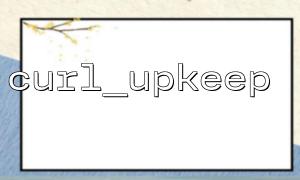In the Laravel project, sometimes we need to send HTTP requests to exchange data with other servers. In order to facilitate developers to send HTTP requests, Laravel comes with its own HTTP client. However, using cURL to send HTTP requests is still a common practice, especially when we need to customize the request header or other complex settings.
The curl_upkeep() function is an encapsulation function that helps developers manage cURL requests. It makes complex cURL operations more concise and easy to manage. In this article, we will explore how to encapsulate curl_upkeep() in Laravel and discuss the practical application scenarios it is suitable for.
curl_upkeep() is an encapsulation function for sending HTTP requests, usually to configure and execute cURL requests more concisely. It makes the process of calling cURL clearer and provides better exception handling and retry mechanisms. It will handle common cURL settings (such as request type, timeout time, request header, return format, etc.) internally, allowing developers to focus on specific business logic.
First, we need to create a service class to encapsulate curl_upkeep() . In Laravel, the way to create a service class is very easy. You only need to use the artisan command to generate a new class file:
php artisan make:service CurlUpkeepService
In the generated CurlUpkeepService class, we will write the encapsulated curl_upkeep() method:
namespace App\Services;
use Exception;
class CurlUpkeepService
{
public function curl_upkeep($url, $method = 'GET', $data = [])
{
$ch = curl_init();
// Set requested URL
curl_setopt($ch, CURLOPT_URL, $url);
// Set the request method,The default is GET ask
curl_setopt($ch, CURLOPT_CUSTOMREQUEST, strtoupper($method));
// in the case of POST ask,Pass data
if ($method == 'POST') {
curl_setopt($ch, CURLOPT_POSTFIELDS, http_build_query($data));
}
// Set the returned content to output directly
curl_setopt($ch, CURLOPT_RETURNTRANSFER, true);
// 设置ask头
curl_setopt($ch, CURLOPT_HTTPHEADER, [
'Content-Type: application/x-www-form-urlencoded',
]);
// 执行ask
$response = curl_exec($ch);
// Error handling
if ($response === false) {
throw new Exception('Curl error: ' . curl_error($ch));
}
// closure cURL Session
curl_close($ch);
return $response;
}
}
Next, in the controller we depend on the CurlUpkeepService service and use it to perform HTTP requests:
namespace App\Http\Controllers;
use App\Services\CurlUpkeepService;
class ExampleController extends Controller
{
protected $curlUpkeepService;
public function __construct(CurlUpkeepService $curlUpkeepService)
{
$this->curlUpkeepService = $curlUpkeepService;
}
public function fetchData()
{
$url = 'https://m66.net/api/data';
$response = $this->curlUpkeepService->curl_upkeep($url, 'GET');
return response()->json(json_decode($response));
}
}
In the above code, we initiate a GET request through the curl_upkeep() encapsulation function and return the response result.
curl_upkeep() is mainly used in scenarios where HTTP requests are required and high customization is desired. Here are some typical application scenarios:
If you need to submit form data to the remote server (e.g., user registration or login), we can use a POST request and pass the form data to the curl_upkeep() function:
$data = [
'username' => 'user123',
'password' => 'securepassword',
];
$url = 'https://m66.net/api/login';
$response = $this->curlUpkeepService->curl_upkeep($url, 'POST', $data);
In many applications, developers need to interact with third-party APIs, get data or submit requests. The curl_upkeep() function is very suitable in this scenario, especially when a third-party API request requires specific request headers or authentication information.
$data = ['key' => 'value'];
$url = 'https://m66.net/api/endpoint';
$response = $this->curlUpkeepService->curl_upkeep($url, 'POST', $data);
The curl_upkeep() encapsulation function can also add exception handling and retry mechanisms according to requirements. For example, if the request fails, we can try again a certain number of times until the request succeeds:
public function curl_upkeep($url, $method = 'GET', $data = [], $retries = 3)
{
$attempts = 0;
while ($attempts < $retries) {
try {
$response = $this->executeCurl($url, $method, $data);
return $response;
} catch (Exception $e) {
$attempts++;
if ($attempts >= $retries) {
throw new Exception('Maximum retry attempts reached: ' . $e->getMessage());
}
}
}
}
Encapsulating the curl_upkeep() function in Laravel can help developers make HTTP requests more efficiently, especially in scenarios where high customization settings or handling complex requests are required. By encapsulation, we can abstract the duplicate cURL request logic into reusable services, improve the maintainability of the code, and simplify the calling process.
Suitable application scenarios include but are not limited to sending form data, calling third-party APIs, implementing asynchronous requests, etc. This makes curl_upkeep() a very useful tool when communicating with external systems.















